Flags of the Confederate States of America
Three successive designs served as the official national flag of the Confederate States of America (the "Confederate States" or the "Confederacy") during its existence from 1861 to 1865. The flags were known as the "Stars and Bars", used from 1861 to 1863, the "Stainless Banner", used from 1863 to 1865, and the "Blood-Stained Banner", used in 1865 shortly before the Confederacy's dissolution. A rejected national flag design was also utilized as a battle flag by the Confederate army and featured in the "Stainless Banner" and "Blood-Stained Banner" designs. Although this design was never a national flag, it is commonly recognized as a symbol of the Confederacy.
.svg.png) The first national flag of the Confederate States of America with 13 stars each representing a state. | |
| Name | "The Stars and Bars" |
|---|---|
| Use | National flag |
| Adopted | March 4, 1861 (first 7-star version) November 28, 1861 (final 13-star version) |
| Design | Three horizontal stripes of equal height, alternating red and white, with a blue square two-thirds the height of the flag as the canton. Inside the canton are white five-pointed stars of equal size, arranged in a circle and pointing outward. |
| Designed by | Nicola Marschall |
.svg.png) The second national flag of the Confederate States of America | |
| Name | "The Stainless Banner"[lower-alpha 1] |
| Use | National flag |
| Proportion | 1:2[lower-alpha 2] |
| Adopted | May 1, 1863 |
| Design | A white rectangle two times as wide as it is tall, a red quadrilateral in the canton, inside the canton is a blue saltire with white outlining, with thirteen white five-pointed stars of equal size inside the saltire. |
.svg.png) The third national flag of the Confederate States of America. | |
| Name | "The Blood-Stained Banner" |
| Use | National flag |
| Proportion | 2:3 |
| Adopted | March 4, 1865 |
| Design | A white rectangle, one-and-a-half times as wide as it is tall, a red vertical stripe on the far right of the rectangle, a red quadrilateral in the canton, inside the canton is a blue saltire with white outlining, with thirteen white five-pointed stars of equal size inside the saltire.[lower-alpha 3] |
| Designed by | Arthur L. Rogers[13] |
Since the end of the American Civil War, private and official use of Confederacy's flags, particularly the battle flag, has continued amid philosophical, political, cultural, and racial controversy in the United States. These include flags displayed in states; cities, towns and counties; schools, colleges and universities; private organizations and associations; and by individuals.
The state flag of Mississippi features the Confederate army's battle flag in the canton, or upper left corner, the only current U.S. state flag to do so. The state flag of Georgia is very similar to the "Stars and Bars"; a prior design incorporating the Confederate battle flag was in use from 1956 until 2001.
First flag: the "Stars and Bars" (1861–1863)
.svg.png) First national flag with 7 stars
First national flag with 7 stars
(March 4 – May 21, 1861).svg.png) First national flag with 9 stars
First national flag with 9 stars
(May 21 – July 2, 1861).svg.png) First national flag with 11 stars
First national flag with 11 stars
(July 2 – November 28, 1861).svg.png) First national flag with 13 stars
First national flag with 13 stars
(December 10, 1861 – May 1, 1863)[14]
The first official national flag of the Confederacy, often called the Stars and Bars, flew from March 4, 1861, to May 1, 1863. It was designed by Prussian-American artist Nicola Marschall in Marion, Alabama, and resembled the Flag of Austria, with which Marschall would have been familiar.[15][16] The "Stars and Bars" flag was adopted March 4, 1861, in the first temporary national capital of Montgomery, Alabama, and raised over the dome of that first Confederate capitol. Marschall also designed the Confederate army uniform.[16]
A monument in Louisburg, North Carolina, claims the "Stars and Bars" "was designed by a son of North Carolina / Orren Randolph Smith / and made under his direction by / Catherine Rebecca (Murphy) Winborne. / Forwarded to Montgomery, Ala. Feb 12, 1861, / Adopted by the Provisional Congress March 4, 1861".[17]
One of the first acts of the Provisional Confederate Congress was to create the Committee on the Flag and Seal, chaired by William Porcher Miles, a congressman and Fire-Eater from South Carolina. The committee asked the public to submit thoughts and ideas on the topic and was, as historian John M. Coski puts it, "overwhelmed by requests not to abandon the 'old flag' of the United States." Miles had already designed a flag that later became known as the Confederate Battle Flag, and he favored his flag over the "Stars and Bars" proposal. But given the popular support for a flag similar to the U.S. flag ("the Stars and Stripes" – originally established and designed in June 1777 during the Revolutionary War), the "Stars and Bars" design was approved by the committee.[18]
When the American Civil War broke out, the "Stars and Bars" caused confusion on the battlefield at the First Battle of Bull Run because of its similarity to the U.S. flag, especially when it was hanging limp, down on the flagstaff.[19] The "Stars and Bars" was also criticized on ideological grounds for its resemblance to the U.S. flag. Many Confederates disliked the Stars and Bars, seeing it as symbolic of a centralized federal power the Confederate states were seceding from.[20] As early as April 1861, a month after the flag's adoption, some were already criticizing the flag, calling it a "servile imitation" and a "detested parody" of the U.S. flag.[3] In January 1862, George William Bagby, writing for the Southern Literary Messenger, wrote that many Confederates disliked the flag. "Every body wants a new Confederate flag," Bagby wrote. "The present one is universally hated. It resembles the Yankee flag and that is enough to make it unutterably detestable." The editor of the Charleston Mercury expressed a similar view: "It seems to be generally agreed that the 'Stars and Bars' will never do for us. They resemble too closely the dishonored 'Flag of Yankee Doodle' … we imagine that the 'Battle Flag' will become the Southern Flag by popular acclaim." William T. Thompson, the editor of the Savannah-based Daily Morning News also objected to the flag, due to its aesthetic similarity to the U.S. flag, which for some Confederates had negative associations with emancipation and abolitionism. Thompson stated in April 1863 that he disliked the adopted flag "on account of its resemblance to that of the abolition despotism against which we are fighting."[1][2][3][4][5][6][7]
Over the course of the flag's use by the Confederacy, additional stars were added to the flag's canton, eventually bringing the total number of stars on the flag to thirteen. This reflected the Confederacy's claims of having admitted Kentucky and Missouri into the Confederacy. Although they were represented in the Confederate Congress for the duration of its meetings, and had shadow governments made up of deposed former state politicians, neither state was ever fully controlled or administered by the Confederacy. The first showing of the 13-star flag was outside the Ben Johnson House in Bardstown, Kentucky; the 13-star design was also in use as the Confederate navy's battle ensign.
Second flag: the "Stainless Banner" (1863–1865)
During the solicitation for a second Confederate national flag, many different types of designs were proposed, nearly all based on the battle flag, which by 1863 had become well-known and popular among those living in the Confederacy. The Confederate Congress specified that the new design be a white field "...with the union (now used as the battle flag) to be a square of two-thirds the width of the flag, having the ground red; thereupon a broad saltire of blue, bordered with white, and emblazoned with mullets or five-pointed stars, corresponding in number to that of the Confederate States."[21]
The flag is also known as the Stainless Banner, and the matter of the person behind its design remains a point of contention. On April 23, 1863, the Savannah Morning News editor William Tappan Thompson, with assistance from William Ross Postell, a Confederate blockade runner, published an editorial championing a design featuring the battle flag on a white background he referred to later as "The White Man's Flag."[6] In explaining the white background, Thompson wrote, "As a people we are fighting to maintain the Heaven-ordained supremacy of the white man over the inferior or colored race; a white flag would thus be emblematical of our cause."[1][2][3][4][7][8][9][10] In a letter to Confederate Congressman C. J. Villeré, dated April 24, 1863, a design similar to Thompson's was proposed by General P. G. T. Beauregard, "whose earlier penchant for practicality had established the precedent for visual distinctiveness on the battlefield, proposed that 'a good design for the national flag would be the present battle-flag as Union Jack, and the rest all white or all blue'....The final version of the second national flag, adopted May 1, 1863, did just this: it set the St. Andrew's Cross of stars in the Union Jack with the rest of the civilian banner entirely white."[22][23][24][25][26][27][28][29]
The Confederate Congress debated whether the white field should have a blue stripe and whether it should be bordered in red. William Miles delivered a speech supporting the simple white design that was eventually approved. He argued that the battle flag must be used, but for a national flag it was necessary to emblazon it, but as simply as possible, with a plain white field.[30] When Thompson received word the Congress had adopted the design with a blue stripe, he published an editorial on April 28 in opposition, writing that "the blue bar running up the centre of the white field and joining with the right lower arm of the blue cross, is in bad taste, and utterly destructive of the symmetry and harmony of the design."[1][5] Confederate Congressman Peter W. Gray proposed the amendment that gave the flag its white field.[31] Gray stated that the white field represented "purity, truth and freedom."[32]
Regardless of who truly originated the design of the Stainless Banner, whether by heeding Thompson's editorials or Beauregard's letter, the Stainless Banner was officially adopted by the Confederate Congress on May 1, 1863. The flags that were actually produced by the Richmond Clothing Depot used the 1.5:1 ratio adopted for the Confederate navy's battle ensign, rather than the official 2:1 ratio.[11]
Initial reaction to the second national flag was favorable, but over time it became criticized for being "too white." Military officers also voiced complaints about the flag being too white, for various reasons, such as the danger of being mistaken for a flag of truce, especially on naval ships, and that it was too easily soiled.[13] The Columbia-based Daily South Carolinian observed that it was essentially a battle flag upon a flag of truce and might send a mixed message. Due to the flag's resemblance to one of truce, some Confederate soldiers cut off the white portion of the flag, leaving only the canton.[33]
The first official use of the "Stainless Banner" was to drape the coffin of General Thomas J. "Stonewall" Jackson as it lay in state in the Virginia capitol, May 12, 1863.[34] As a result of this first usage, the flag received the alternate nickname of the "Jackson Flag".
Third flag: the "Blood-Stained Banner" (1865)
.svg.png) Third national flag (after March 4, 1865)
Third national flag (after March 4, 1865).svg.png) Third national flag as commonly manufactured, with a square canton
Third national flag as commonly manufactured, with a square canton
The third national flag (also called the "Blood-Stained Banner") was adopted March 4, 1865. The red vertical bar was proposed by Major Arthur L. Rogers, who argued that the pure white field of the Second National flag could be mistaken as a flag of truce: when hanging limp in no wind, the flag's "Southern Cross" canton could accidentally stay hidden, so the flag could mistakenly appear all white.
Rogers lobbied successfully to have this alteration introduced in the Confederate Senate. He defended his redesign as having "as little as possible of the Yankee blue", and described it as symbolizing the primary origins of the people of the Confederacy, with the saltire of the Scottish flag and the red bar from the flag of France.[13]
The Flag Act of 1865, passed by the Confederate congress near the very end of the War, describes the flag in the following language:
The Congress of the Confederate States of America do enact, That the flag of the Confederate States shall be as follows: The width two-thirds of its length, with the union (now used as the battle flag) to be in width three-fifths of the width of the flag, and so proportioned as to leave the length of the field on the side of the union twice the width of the field below it; to have the ground red and a broad blue saltire thereon, bordered with white and emblazoned with mullets or five pointed stars, corresponding in number to that of the Confederate States; the field to be white, except the outer half from the union to be a red bar extending the width of the flag.[12]
Despite the passage of the Flag Act of 1865, very few of these third national flags were actually manufactured and put into use in the field, with many Confederates never seeing the flag. Moreover, the ones made by the Richmond Clothing Depot used the square canton of the second national flag rather than the slightly rectangular one that was specified by the law.[12]
Other flags
In addition to the national flags of the Confederacy, a wide variety of flags and banners were flown by Southerners during the Civil War. Most famously, the "Bonnie Blue Flag" was used as an unofficial flag during the early months of 1861. It was flying above the Confederate batteries that first opened fire on Fort Sumter in Charleston harbor, in South Carolina beginning the Civil War. The "Van Dorn battle flag" was also carried by Confederate troops fighting in the Trans-Mississippi and Western theaters of war. In addition, many military units had their own regimental flags they would carry into battle.[35]
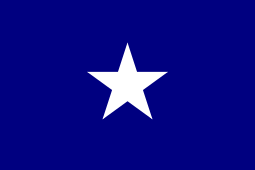 The "Bonnie Blue Flag"—an unofficial flag in 1861
The "Bonnie Blue Flag"—an unofficial flag in 1861 The "Van Dorn battle flag" used in the Western theaters of operation
The "Van Dorn battle flag" used in the Western theaters of operation Flag of the Army of Northern Virginia or "Robert E. Lee Headquarters Flag"
Flag of the Army of Northern Virginia or "Robert E. Lee Headquarters Flag"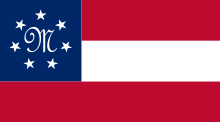 7-star First national flag of the Confederate States Marine Corps
7-star First national flag of the Confederate States Marine Corps Flag of the First Corps, Army of Tennessee
Flag of the First Corps, Army of Tennessee Flag of the 1st Cherokee Mounted Rifles, under General Stand Watie
Flag of the 1st Cherokee Mounted Rifles, under General Stand Watie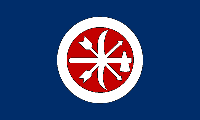 Flag of the 1st Choctaw War Regiment, under Lieutenant Colonel Faunceway Baptiste
Flag of the 1st Choctaw War Regiment, under Lieutenant Colonel Faunceway Baptiste The first battle flag of the Perote Guards (Company D, 1st Regiment Alabama Infantry). Flag officially used: September 1860 – Summer, 1861
The first battle flag of the Perote Guards (Company D, 1st Regiment Alabama Infantry). Flag officially used: September 1860 – Summer, 1861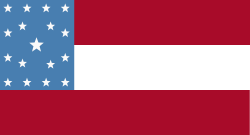 George P. Gilliss flag, also known as the Biderman Flag, the only Confederate flag captured in California (Sacramento)
George P. Gilliss flag, also known as the Biderman Flag, the only Confederate flag captured in California (Sacramento) The "Sibley Flag", Battle Flag of the Army of New Mexico, commanded by General Henry Hopkins Sibley.
The "Sibley Flag", Battle Flag of the Army of New Mexico, commanded by General Henry Hopkins Sibley. The ensign of the Confederate States Revenue Service, designed by Dr. H. P. Capers of South Carolina on April 10, 1861.
The ensign of the Confederate States Revenue Service, designed by Dr. H. P. Capers of South Carolina on April 10, 1861.
Flags of individual Confederate states
| State | Flag |
|---|---|
| Alabama | .svg.png) .svg.png) |
| Arkansas | No state flag until 1913 |
| Florida | .svg.png) |
| Georgia (unofficial) |
.svg.png) |
| Louisiana | .svg.png) |
| Mississippi | .svg.png) |
| North Carolina | .svg.png) |
| South Carolina | .svg.png) 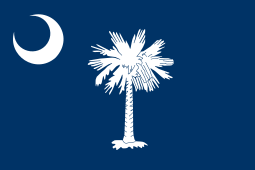  |
| Tennessee |  |
| Texas | 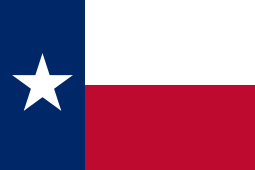   |
| Virginia | .svg.png) |
Battle flag




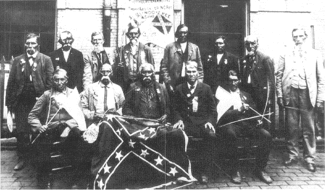
At the First Battle of Manassas, near Manassas, Virginia, the similarity between the "Stars and Bars" and the "Stars and Stripes" caused confusion and military problems. Regiments carried flags to help commanders observe and assess battles in the warfare of the era. At a distance, the two national flags were hard to tell apart.[36] In addition, Confederate regiments carried many other flags, which added to the possibility of confusion.
After the battle, General P. G. T. Beauregard wrote that he was "resolved then to have [our flag] changed if possible, or to adopt for my command a 'Battle flag', which would be Entirely different from any State or Federal flag."[19] He turned to his aide, who happened to be William Porcher Miles, the former chairman of the Confederate Congress's Committee on the Flag and Seal. Miles described his rejected national flag design to Beauregard. Miles also told the Committee on the Flag and Seal about the general's complaints and request that the national flag be changed. The committee rejected the idea by a four-to-one vote, after which Beauregard proposed the idea of having two flags. He described the idea in a letter to his commanding General Joseph E. Johnston:
- I wrote to [Miles] that we should have 'two' flags — a 'peace' or parade flag, and a 'war' flag to be used only on the field of battle — but congress having adjourned no action will be taken on the matter — How would it do us to address the War Dept. on the subject of Regimental or badge flags made of red with two blue bars crossing each other diagonally on which shall be introduced the stars, ... We would then on the field of battle know our friends from our Enemies.[19]
The flag that Miles had favored when he was chairman of the "Committee on the Flag and Seal" eventually became the battle flag and, ultimately, the most popular flag of the Confederacy. According to Museum of the Confederacy Director John Coski, Miles' design was inspired by one of the many "secessionist flags" flown at the South Carolina secession convention in Charleston of December 1860. That flag was a blue St George's Cross (an upright or Latin cross) on a red field, with 15 white stars on the cross, representing the slave-holding states,[37][38] and, on the red field, palmetto and crescent symbols. Miles received a variety of feedback on this design, including a critique from Charles Moise, a self-described "Southerner of Jewish persuasion." Moise liked the design but asked that "... the symbol of a particular religion not be made the symbol of the nation." Taking this into account, Miles changed his flag, removing the palmetto and crescent, and substituting a heraldic saltire ("X") for the upright cross. The number of stars was changed several times as well. He described these changes and his reasons for making them in early 1861. The diagonal cross was preferable, he wrote, because "it avoided the religious objection about the cross (from the Jews and many Protestant sects), because it did not stand out so conspicuously as if the cross had been placed upright thus." He also argued that the diagonal cross was "more Heraldric [sic] than Ecclesiastical, it being the 'saltire' of Heraldry, and significant of strength and progress."[39]
According to Coski, the Saint Andrew's Cross (also used on the flag of Scotland as a white saltire on a blue field) had no special place in Southern iconography at the time, and if Miles had not been eager to conciliate the Southern Jews, his flag would have used the traditional upright "Saint George's Cross" (as used on the flag of England, a red cross on a white field). A colonel named James B. Walton submitted a battle flag design essentially identical to Miles' except with an upright Saint George's cross, but Beauregard chose the diagonal cross design.[40]
Miles' flag and all the flag designs up to that point were rectangular ("oblong") in shape. General Johnston suggested making it square to conserve material. Johnston also specified the various sizes to be used by different types of military units. Generals Beauregard and Johnston and Quartermaster General Cabell approved the design of the 12-star Confederate Battle Flag at the Ratcliffe home, which served briefly as Beauregard's headquarters, near Fairfax Court House in September 1861. The 12th star represented Missouri. President Jefferson Davis arrived by train at Fairfax Station soon after and was shown the design for the new battle flag at the Ratcliffe House. Hetty Cary and her sister and cousin made prototypes. One such 12-star flag resides in the collection of Richmond's Museum of the Confederacy and the other is in the Confederate Memorial Hall Museum in New Orleans.
On November 28, 1861, Confederate soldiers in General Robert E. Lee's newly reorganized Army of Northern Virginia received the new battle flags in ceremonies at Centreville and Manassas, Virginia, and carried them throughout the Civil War. Beauregard gave a speech encouraging the soldiers to treat the new flag with honor and that it must never be surrendered. Many soldiers wrote home about the ceremony and the impression the flag had upon them, the "fighting colors" boosting morale after the confusion at the Battle of First Manassas. From then on, the battle flag grew in its identification with the Confederacy and the South in general.[41] The flag's stars represented the number of states in the Confederacy. The distance between the stars decreased as the number of states increased, reaching thirteen when the secessionist factions of Kentucky and Missouri joined in late 1861.[42]
The Army of Northern Virginia battle flag assumed a prominent place post-war when it was adopted as the copyrighted emblem of the United Confederate Veterans. Its continued use by the Southern Army's post-war veterans groups, the United Confederate Veterans (U.C.V.) and the later Sons of Confederate Veterans, (S.C.V.), and elements of the design by related similar female descendants organizations of the United Daughters of the Confederacy, (U.D.C.), led to the assumption that it was, as it has been termed, "the soldier's flag" or "the Confederate battle flag".
The square "battle flag" is also properly known as "the flag of the Army of Northern Virginia". It was sometimes called "Beauregard's flag" or "the Virginia battle flag". A Virginia Department of Historic Resources marker declaring Fairfax, Virginia as the birthplace of the Confederate battle flag was dedicated on April 12, 2008, near the intersection of Main and Oak Streets, in Fairfax, Virginia.[43][44][45]
Naval jacks and ensigns
The fledgling Confederate States Navy adopted and used several types of flags, banners, and pennants aboard all CSN ships: jacks, battle ensigns, and small boat ensigns, as well as commissioning pennants, designating flags, and signal flags.
The First Confederate Navy jacks, in use from 1861 to 1863, consisted of a circle of seven to fifteen five-pointed white stars against a field of "medium blue." It was flown forward aboard all Confederate warships while they were anchored in port. One seven-star jack still exists today (found aboard the captured ironclad CSS Atlanta) that is actually "dark blue" in color (see illustration below, left).[46]
The Second Confederate Navy Jack was a rectangular cousin of the Confederate Army's battle flag and was in use from 1863 until 1865. It existed in a variety of dimensions and sizes, despite the CSN's detailed naval regulations. The blue color of the diagonal saltire's "Southern Cross" was much lighter than the dark blue of the battle flag.[46]
.svg.png)
The First Confederate Navy Jack, 1861–1863
.svg.png)
The First Confederate Navy Ensign, 1861–1863
.svg.png)
The Second Confederate Navy Jack, 1863–1865
.svg.png)
The Second Confederate Navy Ensign, 1863–1865

The Second Navy Ensign of the ironclad CSS Atlanta
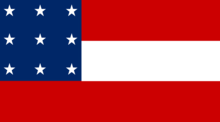
The 9-star First Naval Ensign of the paddle steamer CSS Curlew
.png)
The 11-star Ensign of the Confederate Privateer Jefferson Davis

A 12-star First Confederate Navy Ensign of the gunboat CSS Ellis, 1861–1862
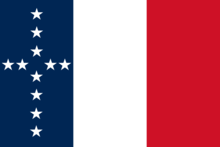
The Command flag of Captain William F. Lynch, flown as ensign of his flagship, CSS Seabird, 1862
.jpg)
Pennant of Admiral Franklin Buchanan, CSS Tennessee, at Battle of Mobile Bay, August 5, 1864

Digital recreation of Admiral Buchanan's pennant
.png)
Admiral's Rank flag of Franklin Buchanan, also flown from the CSS Tennessee during the battle of Mobile Bay
Confederate naval flag, captured when General William Sherman took Savannah, Georgia, 1864
The first national flag, also known as the Stars and Bars (see above), served from 1861 to 1863 as the Confederate Navy's first battle ensign. It was generally made with an aspect ratio of 2:3, but a few very wide 1:2 ratio ensigns still survive today in museums and private collections. As the Confederacy grew, so did the numbers of white stars seen on the ensign's dark blue canton: seven-, nine-, eleven-, and thirteen-star groupings were typical. Even a few fourteen- and fifteen-starred ensigns were made to include states that were expected to secede but never completely joined the Confederacy.
The second national flag was later adapted as a naval ensign, using a shorter 2:3 ratio than the 1:2 ratio adopted by the Confederate Congress for the national flag. This particular battle ensign was the only example taken around the world, finally becoming the last Confederate flag lowered in the Civil War; this happened aboard CSS Shenandoah in Liverpool, England on November 7, 1865.
Controversy
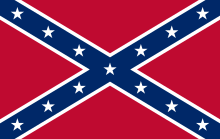
Despite never having historically represented the Confederate States of America as a country, nor having been officially recognized as one of its national flags, the Battle Flag of the Army of Northern Virginia and its variants are now flag types commonly referred to as the Confederate Flag. This design has become a widely recognized symbol of the Southern United States[47], racism and white supremacy.[48][49] It is also known as the rebel flag, Dixie flag, and Southern cross. It is sometimes incorrectly referred to as the Stars and Bars, the name of the first national Confederate flag.[50] The "rebel flag" is a highly divisive and polarizing symbol in the United States.[51][52] A Politico-Morning Consult poll of June 2020 shows that 44% view it as a symbol of Southern pride while 36% say it is a symbol of racism.[53][54]
Gallery
_(1895)_(14576050240).jpg) Drawing in the United Confederate Veterans 1895 Sponsor souvenir album
Drawing in the United Confederate Veterans 1895 Sponsor souvenir album- Jefferson Davis State Historic Site & Museum. The Bonnie Blue Flag is on the right.
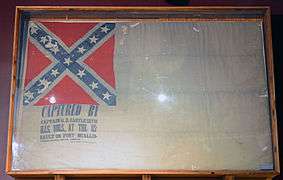 Confederate National flag of Fort McAllister
Confederate National flag of Fort McAllister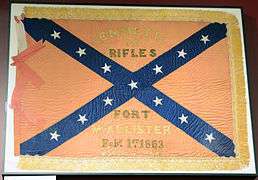 Battle Flag of the Emmett Rifles
Battle Flag of the Emmett Rifles- Confederate National Flag captured from Fort Jackson
 Battle flag of the 11th Mississippi Infantry Regiment used at Antietam
Battle flag of the 11th Mississippi Infantry Regiment used at Antietam- Surrender flag of Army of Northern Virginia
See also
Notes
- William Tappan Thompson, editor of Savannah's Daily Morning News, used a different nickname for the flag, calling it "The White Man's Flag," saying that the flag's white field symbolized the "supremacy of the white man." But it was a nickname that never gained traction with the public.[1][2][3][4][5][6][7][8][9][10]
- Although the officially specified proportions were 1:2, many of the flags that actually ended up being produced used a 1.5:1 aspect ratio.[11]
- Although the officially designated design specified a rectangular canton, many of the flags that ended up being produced utilized a square-shaped canton.[12]
References
- Preble 1872, pp. 414–417
- Preble 1880, pp. 523–525
- Coski, John M. (May 13, 2013). "The Birth of the 'Stainless Banner'". The New York Times. New York: The New York Times Company. Archived from the original on November 7, 2019. Retrieved January 27, 2014.
A handful of contemporaries linked the new flag design to the "peculiar institution" that was at the heart of the South's economy, social system and polity: slavery. Bagby characterized the flag motif as the "Southern Cross" – the constellation, not a religious symbol – and hailed it for pointing 'the destiny of the Southern master and his African slave' southward to 'the banks of the Amazon,' a reference to the desire among many Southerners to expand Confederate territory into Latin America. In contrast, the editor of the Savannah, Ga., Morning News focused on the white field on which the Southern Cross was emblazoned. "As a people, we are fighting to maintain the heaven-ordained supremacy of the white man over the inferior or colored races. A White Flag would be thus emblematical of our cause." He dubbed the new flag "the White Man's Flag," a sobriquet that never gained traction.
- Thompson, William T. (April 23, 1863). "Daily Morning News". Savannah, Georgia.
- Thompson, William T. (April 28, 1863). "Daily Morning News". Savannah, Georgia.
- Thompson, William T. (May 4, 1863). "Daily Morning News". Savannah, Georgia.
- Loewen, James W.; Sebesta, Edward H. (2010). The Confederate and Neo Confederate Reader: The Great Truth about the 'Lost Cause'. Jackson, Mississippi: University Press of Mississippi. p. 13. ISBN 978-1-60473-219-1. OCLC 746462600. Archived from the original on December 13, 2013. Retrieved December 5, 2013.
Confederates even showed their preoccupation with race in their flag. Civil War buffs know that 'the Confederate flag' waved today was never the official flag of the Confederate States of America. Rather, it was the flag of the Army of Northern Virginia. During the war, the Confederacy adopted three official flags. The first, sometimes called 'the Stars and Bars,' drew many objections 'on account of its resemblance to that of the abolition despotism against which we are fighting,' in the words of the editor of the Savannah Morning News, quoted herein.
- Kim, Kyle; Krishnakumar, Priya. "What you should know about the Confederate flag's evolution". Los Angeles Times (June 23, 2015). California. Archived from the original on July 12, 2015. Retrieved July 11, 2015.
- Wood, Marie Stevens Walker (1957). Stevens-Davis and allied families: a memorial volume of history, biography, and genealogy. p. 44. Retrieved September 1, 2015.
This design was suggested by William T. Thompson, editor of the Savannah (Ga.) Morning News, who, in an editorial published April 23, 1863, stated that through this design could be attained all the...
- Allen, Frederick (May 25, 1996). Atlanta Rising: The Invention of an International City 1946–1996. p. 67. ISBN 978-1-4616-6167-2. Retrieved September 1, 2015.
By modern standards, the greatest flaw of the 'Stainless Banner' was its other popular nickname, bestowed by William T. Thompson, editor of the Savannah Daily Morning News, who called it 'the White Man's Flag' and argued that it represented 'the cause of a superior race and a higher civilization contending against ignorance, infidelity, and barbarism' – a bit of racist rhetoric that is plainly unacceptable in current public discourse.
- "The Second Confederate National Flag (Flags of the Confederacy)". Archived from the original on February 9, 2009. Retrieved October 24, 2005.CS1 maint: unfit url (link)
- "The Third Confederate National Flag (Flags of the Confederacy)". Archived from the original on January 30, 2009. Retrieved July 29, 2007.CS1 maint: unfit url (link)
- Coski 2005, pp. 17–18
- "Confederate States of America government". Retrieved October 7, 2014.
- "Nicola Marschall". The Encyclopedia of Alabama. April 25, 2011. Retrieved July 29, 2011.
The flag does resemble that of the Germanic European nation of Austria, which as a Prussian artist, Marschall would have known well.
- Hume, Edgar Erskine (August 1940). "Nicola Marschall: Excerpts from "The German Artist Who Designed the Confederate Flag and Uniform"". The American-German Review. Retrieved June 26, 2015.
- Commemorative Landscapes of North Carolina. "First Confederate Flag and Its Designer O.R. Smith, Louisburg". Wilson Library, University of North Carolina at Chapel Hill.
- Coski 2005, pp. 4–5
- Coski 2005, p. 8
- "The Declarations of Causes of Seceding States". Civil War Trust. Retrieved February 23, 2016.
Our position is thoroughly identified with the institution of slavery—the greatest material interest of the world. Its labor supplies the product which constitutes by far the largest and most important portions of commerce of the earth. These products are peculiar to the climate verging on the tropical regions, and by an imperious law of nature, none but the black race can bear exposure to the tropical sun. These products have become necessities of the world, and a blow at slavery is a blow at commerce and civilization. That blow has been long aimed at the institution, and was at the point of reaching its consummation. There was no choice left us but submission to the mandates of abolition, or a dissolution of the Union, whose principles had been subverted to work out our ruin. That we do not overstate the dangers to our institution, a reference to a few facts will sufficiently prove.
- Coski & The Second Confederate National Flag, Flags of the Confederacy
- Bonner, Robert E., "Flag Culture and the Consolidation of Confederate Nationalism." Journal of Southern History, Vol. 68, No. 2 (May 2002), 318–319.
- "Gen. Beauregard suggested the flag just adopted, or else a field of blue in place of the white." -"Letter from Richmond" by the Richmond correspondent of the Charleston Mercury, May 5, 1863, p.1, c.1.
- John M. Coski, "The Birth of the Stainless Banner," New York Times Opinionator, (May 13, 2013). "Some congressmen and newspaper editors favored making the Army of Northern Virginia battle flag (in a rectangular shape) itself the new national flag. But Beauregard and others felt the nation needed its own distinctive symbol, and so recommended that the Southern Cross be emblazoned in the corner of a white field."
- "Letter of Beauregard to Villere ,April 24, 1863". Daily Dispatch. Richmond, VA. May 13, 1863.
- Coski, John M. (2005). The Confederate Battle Flag: America's Most Embattled Emblem. p. 16. ISBN 978-0-674-02986-6.
- Townsend, Edward D. (August 25, 2017). Saving the Union: My Days with Lincoln and Stanton (Annotated).
- William Parker Snow, Lee and His Generals (1867), p.260 .
- Martinez, J. Michael; Richardson, William D.; McNinch-Su, Ron (2000). Confederate Symbols in the Contemporary South. University Press of Florida. p. 98. ISBN 978-0-8130-1758-7.
- Coski 2005, pp. 16–17
- Journal of the Confederate Congress, Volume 6, p.477
- Richmond Whig, May 5, 1863
- Coski 2005, p. 18
- John D. Wright, The Language of the Civil War, p.284; John M. Coski, The Confederate Battle Flag: America's Most Embattled Emblem (2005), p. 17.
- North & South – The Official Magazine of the Civil War Society, Volume 11, Number 2, Page 30, Retrieved April 16, 2010, "The Stars and Bars" Archived July 14, 2011, at the Wayback Machine
- Gevinson, Alan. "The Reason Behind the 'Stars and Bars". Teachinghistory.org. Retrieved October 8, 2011.
- Coski, John M. (2009). The Confederate Battle Flag. Harvard University Press. p. 5. ISBN 978-0-674-02986-6. Retrieved November 24, 2016.
- Coski 2005, p. 5
- Coski 2005, p. 5: "describes the 15 stars and the debate on religious symbolism."
- Coski 2005, pp. 6–8
- Coski 2005, p. 10
- Coski 2005, p. 11
- "Birthplace of the Confederate Battle Flag". The Historical Marker Database.
- 37 New Historical Markers for Virginia's Roadways (PDF) (Report). Notes on Virginia. Virginia Department of Historic Resources. 2008. p. 71.
B-261: Birthplace of the Confederate Battle Flag
- "2008 Virginia Marker Dedication: Birthplace of the Confederate Battle Flag". FairfaxRifles.org. Retrieved October 5, 2014.
- Loeser, Pete. "American Civil War Flags". Historical Flags of Our Ancestors. Retrieved July 22, 2019.
- Chapman, Roger (2011). Culture Wars: An Encyclopedia of Issues, Viewpoints, and Voices. M.E. Sharpe. p. 114. ISBN 978-0-7656-2250-1. Retrieved February 21, 2013.
- "Confederate Flag". Anti-Defamation League. Retrieved June 10, 2020.
- McWhorter, Diane (April 3, 2005). "'The Confederate Battle Flag': Clashing Symbols". The New York Times. Retrieved June 10, 2020.
- Coski 2005, pp. 58
- Little, Becky (June 26, 2015). "Why the Confederate Flag Made a 20th Century Comeback". National Geographic. National Geographic. Retrieved June 12, 2020.
- The Associated Press (July 10, 2015). "Confederate flag removed: A history of the divisive symbol". Oregon Live.
- Impelli, Michael (June 11, 2020). "44 Percent of Americans Say Confederate Statues Should Remain Standing, Poll Shows". Newsweek. Retrieved June 21, 2020.
- "National Tracking Poll". Politico. p. 21. Retrieved June 21, 2020.
Bibliography
| Library resources about Flags of the Confederate States of America |
- Bonner, Robert. Colors and Blood: Flag Passions of the Confederate South. Princeton University Press, 2002. ISBN 0-691-11949-X.
- Coski, John M. (2005). The Confederate Battle Flag: America's Most Embattled Emblem. United States of America: First Harvard University Press. ISBN 978-0-674-01722-1.
- Katcher, Phillip and Scollins, Rick. Flags of the American Civil War 1: Confederate. (Osprey Men-At-War Series), Osprey Publishing Company, 1993. ISBN 1-85532-270-6.
- Madaus, H. Michael. Rebel Flags Afloat: A Survey of the Surviving Flags of the Confederate States Navy, Revenue Service, and Merchant Marine. Flag Research Center, 1986, Winchester, MA. ISSN 0015-3370. (Eighty-page, all Confederate naval flags issue of "The Flag Bulletin," magazine #115.)
- Marcovitz, Hal. The Confederate Flag, American Symbols and Their Meanings. Mason Crest Publishers, 2002. ISBN 1-59084-035-6.
- Martinez, James Michael; Richardson, William Donald; McNinch-Su, Ron (2000). Confederate Symbols in the Contemporary South. Gainesville, FL: University Press of Florida. pp. 284–285. ISBN 0-8130-1758-0.
- Preble, George Henry (1872). Our Flag: Origin and Progress of the Flag of the United States of America, with an Introductory Account of the Symbols, Standards, Banners and Flags of Ancient and Modern Nations. Albany: Joel Munsell. p. 414. OCLC 612597989.
as a people we are fighting to.
- Preble, George Henry (1880). History of the Flag of the United States of America: And of the Naval and Yacht-Club Signals, Seals, and Arms, and Principal National Songs of the United States, with a Chronicle of the Symbols, Standards, Banners, and Flags of Ancient and Modern Nations (2nd revised ed.). Boston: A. Williams and Company. p. 523. OCLC 645323981.
William Ross Postell Flag.
- Silkenat, David. Raising the White Flag: How Surrender Defined the American Civil War. Chapel Hill: University of North Carolina Press, 2019. ISBN 978-1-4696-4972-6.
Further reading
- 50 Facts You May Not Know About the Confederate Flag, by J. D. Manchester, Starling and Black Publications, ISBN 9781515099222
External links
| Wikimedia Commons has media related to Flags of the Confederate States. |
.png)